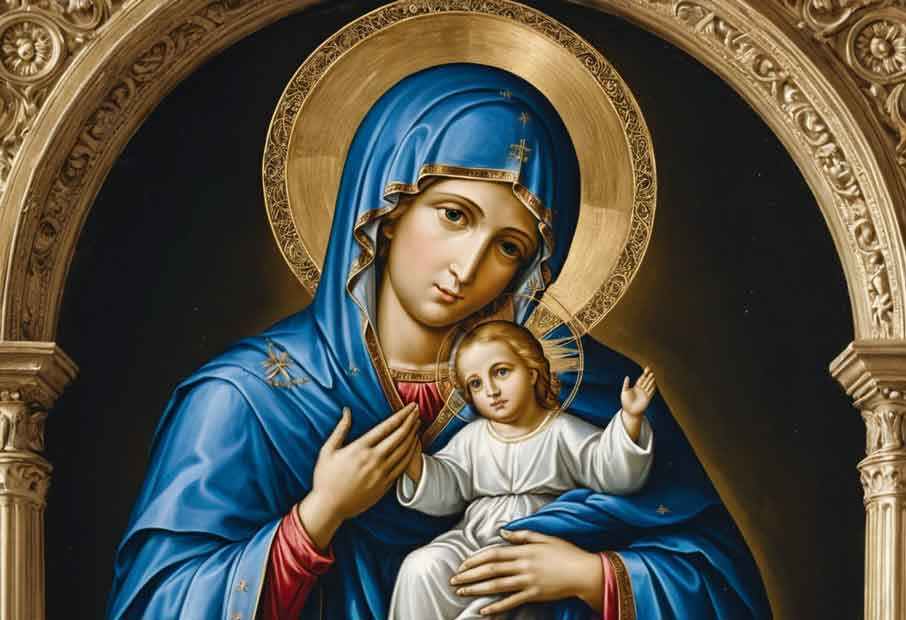Discover the profound significance of the color blue in the Bible, exploring its symbolism related to divinity, purity, and faithfulness. This blog post delves into historical and modern interpretations of blue in biblical contexts, highlighting its appearances in scripture and its impact on spiritual practices. Learn how blue has been represented in biblical art and its enduring legacy in contemporary worship. Understand how this vibrant color continues to inspire believers, serving as a reminder of God’s presence and the spiritual journey. Join us in uncovering the layers of meaning behind blue in the sacred texts.
Blue in the Bible: A Heavenly Perspective

The significance of blue in the Bible is deeply rooted in its symbolism and cultural meanings. This color appears several times throughout the biblical texts, serving not only as a visual representation but also as a profound metaphor. The color blue in the Bible is frequently associated with heaven and divine presence, which exemplifies its importance in spiritual contexts. The hues of blue evoke images of the sky and the ocean, creating a connection to the limitless expanse of the heavens where God resides.
In examining the role of blue in the Bible, one finds that it often symbolizes fidelity, love, and the divine nature of God’s covenant with His people. For instance, the Israelites were instructed to incorporate blue into their garments as a reminder of their commitment to God and His commandments. This particular choice reflects a broader biblical theme where colors are imbued with specific meanings, further enhancing the scriptural narrative.
Furthermore, blue represents holiness and purity. The Tabernacle’s construction included blue fabric, signifying its sacredness and the heavenly origin of God’s dwelling. The recurring presence of blue in various instances within the scriptures enriches our understanding of the divine message being communicated. This color not only captures the essence of heaven but also serves as a reminder of God’s infinite wisdom and the spiritual journey believers embark upon.
In unique expressions throughout the Bible, the associations of blue extend beyond the material and aesthetic; they delve into the spiritual and ethical dimensions of faith. Each mention cultivates an atmosphere of reverence, illustrating the profound connection between color and spirituality in biblical teachings. Analyzing the concept of blue in the Bible sets the stage for a deeper exploration of its multifaceted symbolism and its overarching significance in the religious context.
Historical Context of Colors in the Bible
Colors played a significant role within the cultural and historical context of biblical narratives, embodying various meanings and symbolisms that were vital to the ancient societies. In the Bible, colors were not merely decorative; they conveyed emotions, spiritual concepts, and societal values. The historical usage of colors often connected deeply with the lives and practices of those in biblical times, thus providing a richer understanding of their implications.
Blue in the Bible is particularly noteworthy, as it was seen as a color of divinity and heaven. The use of blue is mentioned in Exodus, specifically when describing the garments of the high priest. Here, blue represented loyalty and faithfulness, often reflecting the connection to the divine. This is a stark contrast to other colors, like red, which symbolized sacrifice and redemption, or gold, representing divinity and wealth. Each color contributed uniquely to the tapestry of biblical storytelling, signifying important themes threaded throughout the scriptures.
The perception of color varied significantly among cultures. For Hebrews, colors were often infused with symbolic meaning; thus, the blue in the Bible would resonate with sacredness. Other ancient civilizations also ascribed various meanings to colors. For instance, Egyptians used blue to evoke the concept of resurrection, thereby elevating its status as a color deeply associated with both life and the afterlife. Understanding these historical nuances allows one to appreciate the significance of blue more profoundly, as it serves not only as an aesthetic choice but also as a rich emblem of theological beliefs.
Additionally, the implications of color symbolism extended into cultural practices, where colors influenced rituals and religious observances. Such patterns underscore the multifaceted role of colors, particularly blue, as reflective of the spiritual truths and values held dearly by ancient peoples. This context not only enriches our understanding of blue in the Bible but also prompts deeper exploration into the roles of other colors that weave through biblical texts.
Biblical References to Blue
The color blue emerges frequently within the biblical narrative, symbolizing a range of spiritual and ceremonial significances. One of the most notable mentions can be found in Exodus 25:4, where God instructs Moses on the materials needed for the construction of the Tabernacle. The verse specifies the inclusion of “blue” as part of the sacred fabrics. In this context, blue signifies divine revelation, embodying God’s presence and holiness. The use of blue in the Tabernacle’s curtains emphasized the importance of the item as the dwelling place of God, reinforcing the connection between heaven and earth.
Another significant biblical reference to blue appears in Numbers 15:38-39, where God commands the Israelites to wear fringes with blue threads on the corners of their garments. This specific instruction serves a dual purpose: to remind the people of God’s commandments and to instill a sense of identity among the Israelites. The blue threads were meant to encourage faithfulness to God’s laws while also symbolizing the divine nature of His instructions. In this way, blue becomes a reminder of the heavenly aspirations that individuals are encouraged to pursue.
Furthermore, blue is featured in the ceremonial garments worn by the priests, particularly in Exodus 28:31-35. The high priest’s robe is described as being made of blue fabric, indicative of his unique role as a mediator between God and the people. The inclusion of blue emphasizes the sacredness of the priestly duties and represents the connection to the divine. Throughout these references, blue serves as a critical color within the biblical context, intertwined with divine holiness, moral guidance, and the importance of ritualistic practices. Each mention enhances our understanding of how blue operates as a symbol of spiritual significance in the biblical narrative.
Symbolism of Blue in Spiritual Context

In the study of scripture, the color blue surfaces frequently and represents a rich tapestry of spiritual significance. Primarily, blue in the Bible embodies divinity and the heavens, offering a visual representation of God’s grandeur and omnipresence. For instance, in Exodus 24:10, the elders of Israel see the God of Israel, and His foot is likened to a pavement of sapphire stone, emphasizing a connection to purity and the divine realm. This portrayal not only underscores God’s majesty but also the transcendence of heaven, where blue is often viewed as a symbol of eternal life and spiritual truth.
Moreover, blue signifies truth in biblical texts. The adherence to spiritual truth and fidelity is often captured through the imagery of blue silk in the garments of the priests, as delineated in the Book of Exodus (28:31). These garments, imbued with blue, represent the covenant between God and His people, highlighting themes of loyalty and divine promises. As stated by biblical scholar Dr. John Durbin, “The presence of blue signifies the absolute truthfulness of God and His unwavering fulfillment of the covenant.” Such interpretations connect the color to a more profound understanding of faith and truth within the Christian tradition.
Additionally, the connection of blue to peace is prominent; it evokes a sense of calmness, reminiscent of clear skies and tranquil waters. This serene quality of blue correlates with aspects of divine peace, as conveyed in Philippians 4:7, where the peace of God guards the hearts of those who believe. The intertwining of blue with imagery reflecting God’s protective presence reinforces its significance in spiritual life. Thus, through its associations with divinity, truth, and peace, blue in the Bible emerges as a crucial element of the spiritual narrative, inviting a deeper contemplation of its role in conveying divine messages.
Theological Interpretations of Blue
Throughout the history of Christianity, the color blue has held multifaceted theological interpretations, varying among different denominations and cultures. In many religious teachings, blue symbolizes divinity and heavenly grace. For instance, it is often associated with the sky, representing God’s transcendent nature. Its presence in biblical texts serves to remind believers of the promise of hope and salvation inherent in the divine plan.
In Roman Catholicism, blue is prominently featured in the liturgical practices, particularly in connection with the Virgin Mary. Traditionally, Mary is adorned in blue robes, symbolizing her purity and connection to the heavens. This depiction reinforces the theological significance of blue as a representation of faith, fostered through devotion to Mary. Additionally, blue has also found its way into sacred art, where it conveys tranquility and serenity, dovetailing with its focus on hope and reassurance in times of spiritual distress.
Moreover, blue holds substantial relevance in other Christian denominations. In some Protestant traditions, blue is viewed as representing the living water of Christ—a vital aspect of believers’ spiritual nourishment. It is included in worship settings, particularly during celebrations of baptism and communion, as a metaphorical reminder of renewal and spiritual cleansing. The interpretation of blue as a color of hope is universal—across different practices, it is constantly aligned with the themes of encouragement and divine promise.
The significance of blue in the Bible, thus, transcends mere aesthetic value; it encapsulates deep theological meanings that resonate with believers across generations. Its role in liturgical practices and forms of worship emphasizes a shared understanding of hope and connection to the divine, reinforcing its importance in the Christian faith.
Visual Representations of Blue in Biblical Art
The color blue has played a significant role in biblical art across various historical periods, often symbolizing divinity, heaven, and spiritual truth. Artists have utilized blue in numerous forms, from frescoes in cathedrals to illuminated manuscripts, highlighting its reverence and association with sacred themes. In paintings, blue typically appears in the robes of biblical figures, such as the Virgin Mary, where it serves as an indicator of her elevated status and purity. The choice of blue for such depictions is often rooted in its association with the heavens, representing both the divine realm and the qualities of compassion and tranquility.

Stained glass windows in medieval churches also exemplify the use of blue in biblical art. Craftsmen often incorporated blue glass to depict key biblical narratives, allowing light to flood through and create a heavenly atmosphere within the sacred architecture. For instance, the use of cobalt blue in these windows not only added depth and richness to the scenes but also reinforced the spiritual messages embedded within the stories. Such artistic elements not only enhanced the worship experience but also served an educational purpose, teaching congregants about biblical tales and their significance.
Furthermore, the cultural significance of blue has evolved over time, reflecting changing artistic styles and theological interpretations. In the Renaissance, for instance, the color blue began to symbolize more than just heaven; it also became associated with artistic mastery, with painters like Raphael and Titian employing blue hues to convey emotional depth and wisdom in their work. As artists continued to explore the transformative power of blue, they enriched the visual narrative of biblical stories, seamlessly blending religious iconography with the evolving cultural landscape. Ultimately, blue in biblical art serves as a poignant reminder of its multifaceted meanings and enduring presence in the portrayal of sacred themes.
Blue in Modern Christian Practice
The color blue has sustained its relevance within modern Christian practices, reflecting its profound significance as originally outlined in biblical texts. Contemporary worship settings often incorporate blue in various forms, including liturgical vestments, altar decorations, and church banners. This integration not only honors traditional practices but also adapts to the evolving expressions of faith in today’s diverse congregations.
In many denominations, blue is prominently featured during specific liturgical seasons, such as Advent and Lent. This practice signifies hope and anticipation, aligning with the biblical connotation of blue as a color of heavenly promise. Additionally, blue vestments worn by clergy can convey purity and the divine nature of Christ, thereby reinforcing the sacred atmosphere of worship. Likewise, the inclusion of blue in altar decorations serves to enhance the spiritual ambiance, inviting congregants to engage more deeply with their faith experience.
The symbolism of blue extends beyond decorations and vestments; it is also present in various contemporary rituals. For example, many Christian weddings incorporate blue elements, symbolizing fidelity and hope for enduring love, thereby linking the couple’s commitment to the biblical associations of this color. Similarly, in baptisms, blue may be used to signify rebirth and renewal, recalling the biblical waters of baptism. Through these practices, the enduring meaning of blue is woven into the lives of worshippers, serving as a constant reminder of their faith journey.
In conclusion, blue in the Bible continues to symbolize essential elements of the Christian faith, such as hope, faith, and purity. By embracing this color in modern practices, the church maintains a vital connection with historical significance while enriching contemporary expressions of spirituality.
Interpreting the Meaning of Blue in the Bible: A Summary
The color blue in the Bible carries a depth of significance that transcends mere aesthetic value. Throughout biblical texts, blue is associated with spirituality and divine communication, often symbolizing the heavens or the presence of God. This connection is not only evident in the descriptions of the tabernacle and the priestly garments but also reflects the broader theological themes inherent in scripture.
One of the most notable aspects of blue in the Bible is its representation of holiness and purity. The use of blue fabric in the construction of the tabernacle signifies a divine connection, providing a medium through which the sacred and the earthly intersect. The emphasis on blue in priestly attire underscores the importance of approaching God with reverence and an awareness of His transcendence. In this way, the color serves as a reminder of the Christian call to holiness, illustrating what it means to live in alignment with divine purposes.
Historically, blue has also served as a symbol of loyalty and fidelity. In various biblical narratives, those who are faithful to God are often likened to the serene and trustworthy nature of the blue sky. This cultural and historical context deepens our understanding of the phrase “blue in the Bible meaning,” as it intertwines with themes of commitment, trust, and enduring faith. In artistic contexts, blue has been utilized in sacred art to represent the Virgin Mary, further linking the color to the divine feminine and motherhood.
Overall, what does the color blue mean in the Bible can be seen through the lenses of divine authority, purity, loyalty, and artistic representation. By recognizing these multifaceted meanings, readers can appreciate the importance of blue as a powerful color that encapsulates key spiritual truths woven throughout scripture.
Conclusion: The Enduring Legacy of Blue in Biblical Texts
Throughout the examination of blue in the Bible, it becomes evident that this color carries profound significance, extending its meaning beyond mere aesthetics. In various contexts, blue symbolizes divine presence, heavenly realms, and covenantal relationships. The invocation of blue in sacred garments, such as the priestly robes, illustrates its role in setting apart those chosen to carry out God’s service. Furthermore, blue is intricately linked to themes of loyalty, trust, and the sanctity of God’s commandments, reinforcing its importance within the biblical narrative.
Readers and believers today may reflect on the impact of blue as they engage with biblical texts, allowing for a deeper understanding of the spiritual dimensions associated with this color. As a representation of the heavens, blue reminds individuals of their aspirations towards the divine, beckoning seekers to consider their place within the vast expanse of creation. Moreover, the connections between blue and aspects such as faithfulness and the authority of God’s word serve as timeless lessons, beckoning contemporary audiences to embody these virtues in their own lives.
The enduring legacy of blue in the Bible also invites further inquiry into related topics, such as the meanings of different colors within scripture. Exploration of these themes encourages a more comprehensive understanding of the text, inviting readers to recognize the intricate tapestry of symbolism woven throughout the Bible. For those intrigued by this topic, delving into articles discussing red in the Bible or color green in the Bible may offer valuable perspectives and insights. Ultimately, the significance of blue transcends the pages of scripture, continuing to inspire reflection and spiritual growth among believers, reinforcing its relevance in today’s world.









